
Corporate Fitness Challenge Ideas for Your Company
Promoting workers’ health and well-being is beneficial for both employees and organizations. Discover invigorating fitness challenges tailored for your corporate environments.


President at KOM Growth
Whether acute or chronic, mild or debilitating, everyone experiences pain at some point. Most people have worked while in pain, too.
When we factor in the aging workforce, constant stress, and a demanding work environment, it seems that pain, especially chronic, is set to become an even more pressing issue in the workplace.
Research shows that the prevalence of chronic pain is increasing for all demographics of the working population, creating an urgency for employers to support prevention and early access to pain management resources.
But, beyond the ethical obligation, addressing pain-related matters can also benefit the company. After all, a healthy employee is a productive one.
How organizations can achieve better productivity and well-being and to what extent is the topic of this Shortlister article, where we explore strategies employers can use to enhance employee access to pain management resources.
Pain management is a branch of healthcare and medicine that focuses on controlling a person’s acute or chronic pain, allowing them to relieve discomfort and improve their quality of life. It’s a comprehensive approach incorporating pain medication, hands-on treatment, exercise, psychological therapy, and mind and body techniques.
Whether it’s caused by a disease, chronic illness, injury, or disorder, pain is the most prevailing symptom we seek medical help for.
Even though everyone experiences and perceives it differently based on genetic, biological, or psychological factors, some of the most common conditions that require pain management are:
The many causes behind pain make its management challenging, since one must address the underlying issue before treating it.
Dismissing or misdiagnosing pain can have grave consequences, worsen an underlying condition, and cause further complications.
The Washington Post reports that this is a common issue regarding the female experience with healthcare. Namely, despite women’s higher pain sensitivity, there’s a “pain gap” in their treatment for many health issues, including heart problems, reproductive health, chronic conditions, and more.
Beyond gender, decades of over-prescribing opioid medication as the go-to solution for pain have created widespread misuse and addiction to painkillers, resulting in a national opioid epidemic.
The mistreatment, lack of understanding, and stigmatization have exacerbated these health concerns, necessitating a better approach to pain management, especially when dealing with chronic pain.
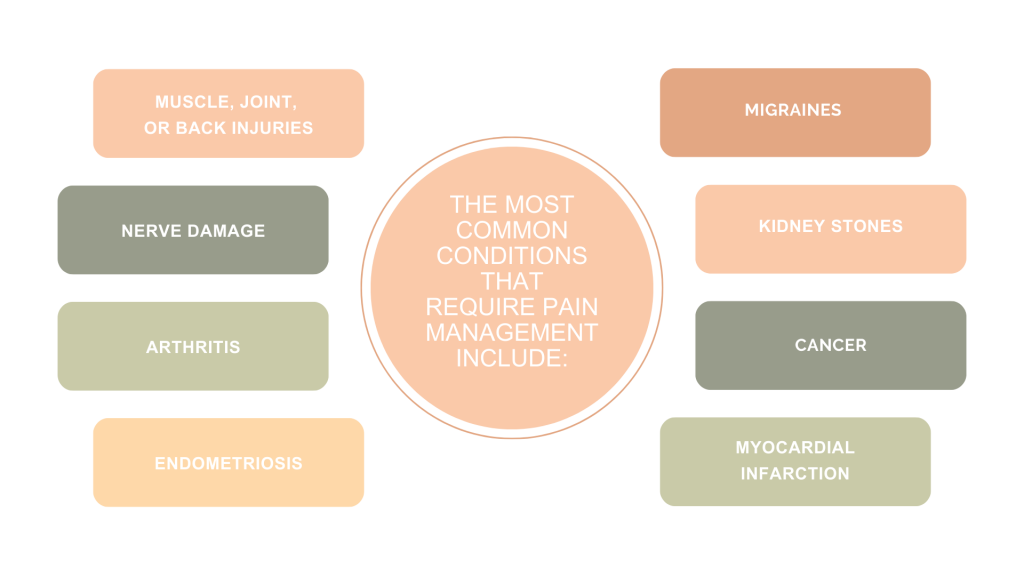
Chronic pain has become a public health concern, costing the U.S. economy up to $635 billion, shows a report by the American Pain Society.
Over 50 million Americans experience it, comprising 20% of the U.S. adult population. Of those, 6.9% live with high-impact pain, restricting them from everyday activities, reports the Centers for Disease Control and Prevention (CDC).
Moreover, research shows that, compared to other chronic conditions like diabetes and depression, long-lasting pain has become more prevalent in recent years. The study also underscores the effect of poor pain treatment, since people who experience nonchronic pain were twice as likely to report it becoming chronic a year later.
While other estimates on chronic pain place the number between 11% and 40%, one thing is certain – pain impacts millions of people every day.
Although it often goes unnoticed, its economic, psychological, and social impact is monumental in the workplace.
In fact, according to the report by the American Pain Society, lost productivity plays a significant part in the total cost of chronic pain, amounting to $335 billion. Another study places the expense of absenteeism, or loss of productivity from missing work, at $12.7 billion for lost days and an additional $96.5 billion for lost hours.
Although less is known about presentism, some sources reveal that on-the-job productivity loss can be up to three times greater than absenteeism.
While it does have significant economic ramifications for the company, workers are the ones experiencing pain, and failure to address this can worsen their discomfort.
Unfortunately, research on attending work with chronic pain shows managers might not understand and accommodate their workers, since chronic pain often doesn’t have an apparent medical reason. The findings further indicated that employees felt less supported and recognized and experienced more threats and injustice.
Mistreatment and pressuring workers into coming to work prematurely led to their poorer mental health, physical strain, job dissatisfaction, and three times higher absenteeism than co-workers without pain.
The data backs up what we already knew – working with pain leads to burnout, which eventually affects the entirety of the organization, not just employees.
So, understanding chronic pain’s impact on employee wellness and the role leadership plays in this is the first step in supporting pain management and improving employee access to resources.
While the growing needs of the workforce and the evolving work landscape drive change, leaders ensure its continuity.
This symbiotic relationship with their employees’ well-being can benefit everyone when maintained proactively. For example, statistics show that highly successful health and productivity initiatives help companies by:
But at the same time, according to a Buffet National Wellness survey, 60% of workers agree that their employer bears some responsibility for ensuring their overall well-being.
In the context of pain management, that means creating a supportive environment around wellness, where employees feel safe to communicate their needs and get reasonable accommodation.
With the help of HR and managers, leaders can ensure that the workforce has access to pain management resources, healthcare services, and wellness programs.
Another way they can contribute to their employee well-being is by setting the tone for organizational values, emphasizing health and safety as core values, and leading by example. This fosters a culture where individuals feel encouraged to prioritize self-care, normalizing the conversation about working with chronic pain and reducing the stigma.
While this proactive approach sounds promising, there is one problem – managers are not fully aware of the pain experienced by their employees.
A study exploring leadership’s role in assessing workers with musculoskeletal pain and other conditions shows an overall lack of awareness. In fact, how middle managers consider this matter is shaped by the following:
Research further suggests managers don’t discuss health challenges at work enough. This lack of open communication usually stems from either employees’ fear of consequences if they speak up or the managers thinking it’s not their job to address the matter.
Although a standalone example, this study reveals a need for educating managers before setting up employee pain management strategies. Once they overcome this issue, companies can proceed to other pressing matters, like inequality in pain treatment and the need for a holistic approach to well-being.
Between the pain gap and overprescription of painkillers, there seems to be a disconnect between what patients need and what they get.
In 2011, the U.S. Institute of Medicine (IOM) emphasized the need for a cultural transformation in pain treatment that moves away from using medication or procedures as a quick fix. Instead, they proposed an integrated approach, recognizing that each person’s pain experience is unique and influenced by many factors.
More than a decade later, although this outdated model is still prevalent, we acknowledge that pain assessment is a comprehensive process that should reflect and complement a person’s overall well-being.
This is an opportunity for employers to prioritize the holistic health of their employees by implementing comprehensive pain management strategies and improving their access to pain management resources.
Stigma and Chronic Pain, a study exploring chronic pain as a biopsychosocial issue, suggests that improving pain education and expanding knowledge on these conditions can reduce stigma.
Criticizing the “analgesic culture,” researchers argue the need to shift to a holistic model that considers biological, psychological, and sociocultural factors in understanding chronic pain.
Although the study fails to address what this means in the workplace context, it’s safe to assume that seeing pain as a multilayered issue and educating employees can have a positive impact.
Creating a safe space for open dialog can reduce stigmatization, encouraging workers dealing with pain to speak up and request access to accommodation and resources.
That means familiarizing employees and managers with pain-related challenges and fostering a company culture where they feel comfortable sharing their experiences and asking for support.
The “prevention is better than cure” narrative is applicable when it comes to pain assessment at work.
Whether it’s behind a desk or a hands-on job, a proactive approach can prevent environmental factors like a physically arduous job, bad posture, or stress from triggering chronic pain.
For example, investing in ergonomic equipment for proper postures, like comfortable chairs and adjustable desks, can reduce the strain an office job can have on the body. Encouraging regular exercise and breaks can also prevent the onset of pain that can happen from prolonged sitting.
These strategies also apply to hands-on and field jobs, along with protective equipment, task rotation, and a safe working environment to avoid injury.
Stress can cause pain or worsen chronic conditions.
Wellness statistics reveal that 61% of employees are stressed and burnt out. Among the top five stress symptoms that lead to absenteeism, pain takes third place with 24%, right after fatigue and insomnia.
Creating an environment of physical and mental well-being and designing roles and work schedules that complement autonomy and skill variety allow for a balanced workload. As a result, this can reduce stress and minimize the risk of pain-related issues.
An excellent example is the post-COVID increase in flexible work arrangements, like fully remote work, hybrid positions, and flexible hours.
In fact, the 2021 Benefits Canada Healthcare Survey reveals that working from home helped 77% of employees with chronic conditions and pain to miss fewer days at work.
A breakdown of the numbers shows that this was especially beneficial for 93% of employees with arthritis, 83% with chronic pain, and 68% of workers with mental health problems.
The results showcase a need to adapt to the changing work environment, especially when it helps employees feel more comfortable and better manage their health conditions.
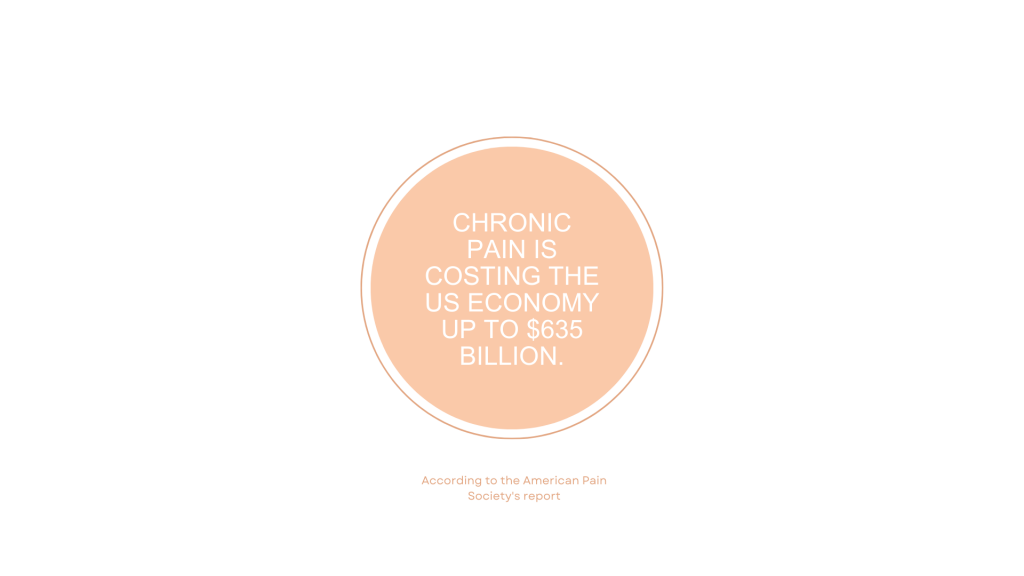
The modern workplace is a result of decades-long technological and societal transformations. Yet, we still have a long way to go regarding pain management.
New technologies and evidence on the socioeconomic impact of pain in the workplace present a need for organizations to adapt to the changing work dynamics.
For example, this may involve incorporating virtual health platforms that offer telemedicine consultations, digital pain management tools, and online resources.
By embracing technological advancements, employers can provide convenient access to pain management support, making it easier for employees to seek help regardless of location or schedule.
The diversity of the workforce in the way they experience and handle pain, along with the nature of their condition, creates the need for an individualistic approach to pain management strategies.
From what we discussed before, tackling this issue can include anything from ergonomic solutions to remote work.
However, beyond these strategies, organizations should expand their access to resources and technologies, starting from their health insurance plans.
“There are many resources available through health insurers, disability insurers, and point solutions to help employees address pain-related disabilities and illnesses,” says Rob LaHayne, President at KOM Growth.

Usually, this includes access to healthcare professionals specializing in pain management, physiotherapists, and chiropractors. Apart from helping them control pain, this allows employees to receive personalized assessments and treatment plans tailored to their specific pain-related concerns.
Beyond insurance-covered services, pain management resources include support groups and education on pain-related matters and employee rights.
These are crucial in fostering community and shared experiences among workers dealing with pain and ensuring they receive reasonable accommodation. Familiarizing the workforce with the challenges and solutions can equip them with tools to address pain effectively and overcome the stigma surrounding it.
Finally, we can’t overlook the technological advancement in recent years that has undoubtedly impacted how we perceive and treat pain.
Nowadays, there are different apps to track and monitor pain levels and detect symptoms with helpful features like pain diaries, medication reminders, and mood trackers.
Delivering these, along with online resources and websites offering educational materials and expert advice, gives employees full access to pain management resources.
Some resources to consider include:
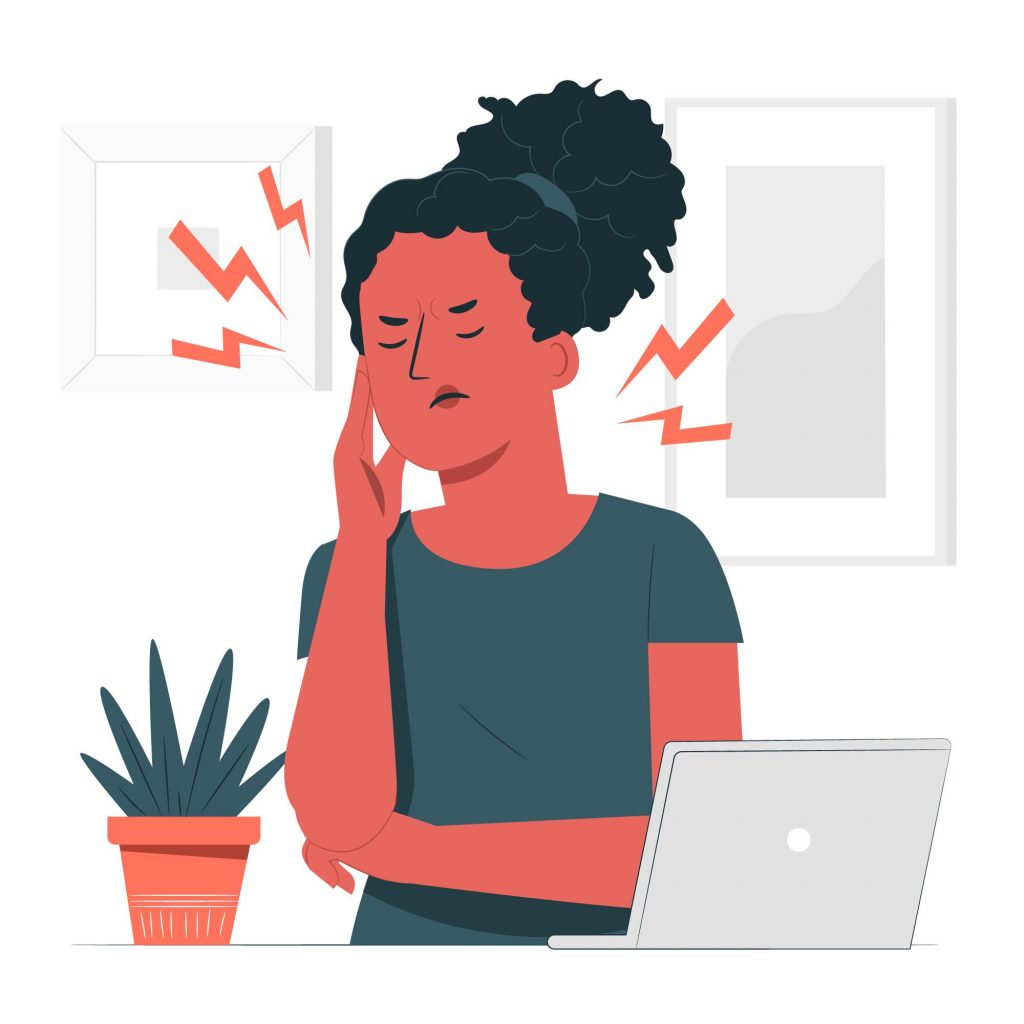
The past few years brought to light many issues in how we approach healthcare. However, they also introduced solutions we’ve overlooked before regarding pain management.
For one, remote work has emerged as the new workplace trend, even post-pandemic, with statistics showing that 58% of workers can work from home at least once a week. More importantly, 98% said they would work remotely at least some of the time, and 91% had a positive experience with WFH.
Between this and the increasing demand for holistic wellness, companies are undergoing significant changes in how they perceive and assess health issues, with pain management being an essential area of focus.
While it’s hard to determine a future trajectory, pain awareness will likely grow as we become more attuned to individuals’ physical and emotional experiences.
With that in mind, this upcoming Pain Awareness Month is an excellent opportunity for employers to set up the foundation for better understanding and access to pain management resources.
Content Writer at Shortlister
Browse our curated list of vendors to find the best solution for your needs.
Subscribe to our newsletter for the latest trends, expert tips, and workplace insights!

Promoting workers’ health and well-being is beneficial for both employees and organizations. Discover invigorating fitness challenges tailored for your corporate environments.
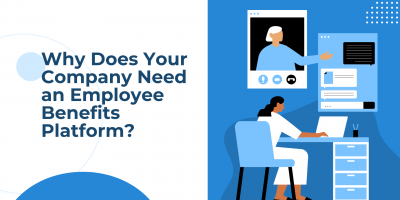
From HR efficiency to employee retention, here’s why companies need to modernize their benefits administration with employee benefits platforms.
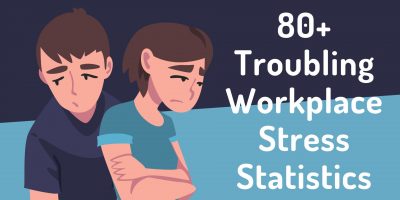
Address workplace stress head-on with practical solutions to encourage a healthier, more productive work environment.

Discover flexible benefits plan’s role in improving recruitment and retention levels and satisfying employees’ needs.
Used by most of the top employee benefits consultants in the US, Shortlister is where you can find, research and select HR and benefits vendors for your clients.
Shortlister helps you reach your ideal prospects. Claim your free account to control your message and receive employer, consultant and health plan leads.